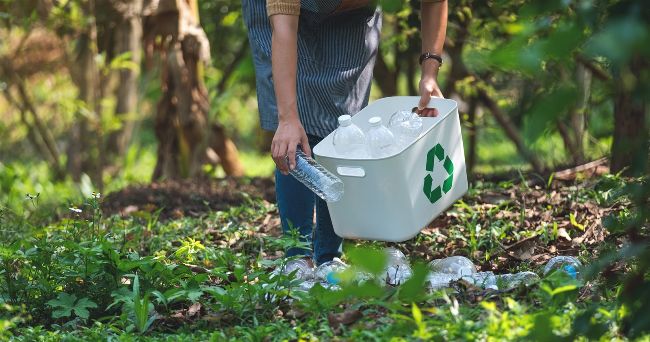Do you know how to perform a waste audit for your spa?
The heart of your spa’s waste management program lies in the measurement aspect of it. GreenSpa.Africa’s Charné le Roux provides some useful guidelines on how to go about the process

Farknot Architect/
Shutterstock.com
In my last report on waste in the spa and wellness industry in the July issue of Professional Beauty, I highlighted the impact of the waste that we generate on our environment and the people who work with us. I also provided a few pointers on waste management best practice.
Conducting a waste audit is the only way of knowing the following:
• What makes up your spa’s waste profile. When we think about waste, we often believe that all waste is deposited in a landfill. The reality of it is that there are different types of waste and each has a unique impact and point of disposal;
• Whether your waste management strategies currently in place are effective;
• If there are opportunities to reevaluate your procurement strategy in order to buy less of what’s being wasted; and
• Whether there are ways to help your business save money by identifying valuable recyclables that can be sold. Regular audits also provide a benchmark for future improvements and importantly, demonstrate to clients and employees that your business is serious about reducing waste.
When we
THINK ABOUT WASTE,
we often
BELIEVE THAT
all waste is
DEPOSITED IN A LANDFILL.
The
REALITY OF IT IS
that there are
DIFFERENT TYPES OF WASTE
and each has a
UNIQUE IMPACT
and
POINT OF DISPOSAL.
Procedure
The following waste audit procedure is what I recommend to all my clients. It should preferably be conducted on a quarterly basis.
1. Choose a waste management team to conduct the audit.
2. Gather all your audit equipment in advance. This will include protective equipment (the team will be physically sorting through waste and must be protected from sharp objects and possible exposure to harmful substances), labels, permanent markers, weighing scale or measuring tape, clear garbage bags, large plastic sheets, containers, tongs, first-aid kit, and an audit sheet.
3. Select an appropriate area where the sorting of waste can be done on a large plastic sheet without interference from wind or other people.
4. Make sure that your audit reports are reviewed by your green team, or administration department, to help determine the major waste streams that you generate, find reduction and recycling opportunities, and address issues that can help improve your waste management objectives.
To get a comprehensive picture of your waste, request your cleaning staff to collect and set aside waste gathered over the course of a few days with the bags properly marked with the types of waste in them (if collected from specially designated bins) and where (which department or section) the waste originated.
Methodology
The actual audit is conducted based on the following methodology. Step 1: Set out your waste. Place the selected waste on an open plastic sheet (that you re-use in future audits). Step 2: Measure the volume of the total waste. The pile will most likely not be entirely regular, therefore, record the average length, width and height of the pile, in centimetres, using a tape measure. Weigh the waste if a big enough scale is available. Step 3: Create an audit sheet noting all the different types of materials present, for example paper, plastic packaging, cotton wool, earbuds, cans, chemical containers, food scraps etc and then categorize them under their waste types, namely compostable, recyclable, hazardous and general waste. The same audit sheet should then be used for all audits going forward. Step 4: Using the same audit sheet, make a note of the number of days, for example 5, over which waste was collected. This time span should be adhered to for all audits. Step 5: Estimate the composition by volume and percentage for each material present and then aggregate the figures, where necessary, to reflect the composition and volume for each waste type.
Your audit sheet will then provide to you an analysis of your waste, which can look, for example, as follows:
• Recyclable Waste 45%
• Compostable Waste 10%
• General Waste 15%
• Hazardous Waste 30%
To get a
COMPREHENSIVE PICTURE
of your waste,
REQUEST YOUR CLEANING STAFF
to collect and
SET ASIDE WASTE
gathered over the
COURSE OF A FEW DAYS
with the
BAGS PROPERLY MARKED
with the
TYPES OF WASTE
in them and where the
WASTE ORIGINATED.
Analysis
Ultimately, using the example above, this intelligence generated by your waste audit, at that particular point in time, will reveal that: a) Recoverable (i.e. compostable or recyclable) materials form the greatest part of the waste, which presents a significant cost saving opportunity. b) Hazardous waste (which should all have originated from the designated hazardous waste receptacles), presents an opportunity for reduction. c) The reduction in waste between the two most recent audits may then suggest that more effort can be made to reduce waste, most likely with respect to packaging. d) More effort can be made to purchase products that come with minimal packaging.
Have a look at my waste audit video for spas as an easy visual guide of the process on my YouTube channel at: https://youtu.be/g-ipUpCNnOg
As turnkey sustainability practitioner, Charné le Roux advocates and influences sustainability in the wellness industry. Her work includes creating the Sustainable Spa Practitioner Course, GreenSpa Guide and GreenSpa Calculator. Email charne@greenspa.africa